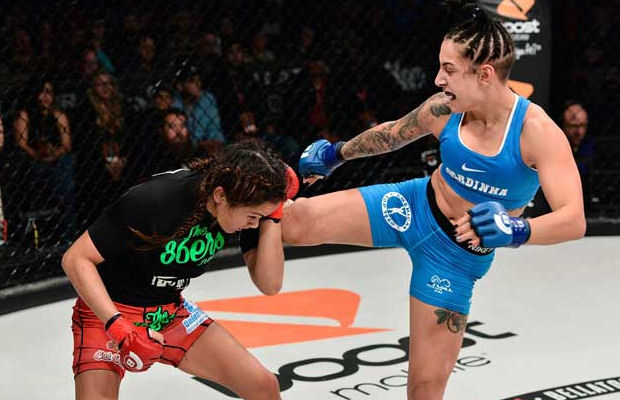

Emily Ducote entered Bellator with a 2-1 record, an unknown and unaccomplished mixed martial artist brought in to fill out the promotions fledgling flyweight division. She made her debut at Bellator 159 versus the undefeated prospect Brazilian Bruna Vargas finishing her in a round and a half by rear naked choke.
Since then Ducote has been on a tear winning another three fights with only one loss to uncrowned flyweight champion Ilima-Lei Macfarlane. Ducote has fought her way to number two in the division and is on the precipice of championship gold. Today we take a look at Ducote’s mixed martial arts game; her strengths, weaknesses and how that can help or hinder her moving forward in her career.
At 23 years old with a record of 6-2. With only a total of eight fights, Ducote is young in life and in her career as a professional fighter. This means that she is a fighter who is not a finished product and should, if she is who I and other analysts believe she is, trend upward in regards to the breadth of her skills, the depth of her skill, and the savviness she has in applying said skills. Nonetheless we can only discuss her based on who she is now, what she has shown recently and comment on that.
With that said Emily is an aggressive counterpuncher, I say counterpuncher instead of counter striker due to the fact that the large majority of her effective offense is generated with her hands. Ducote prefers to march forward behind a high guard, blocking or absorbing her opponent’s strikes as she pushes them back and hopefully works into boxing range. At kicking and long punching range Emily is busy with forward pressure, but rather tame in regards to her own offense or defense.
Once she gets on the edge of boxing range she will throw a 1-2 or a lead right (overhand) to cover the distance to get her in closer to her opponent where she can force exchanges or push them to the cage where she can control them, wear on them and hopefully take them down. Once on the ground Ducote will work for control and will ground and pound in hopes of creating an opening which she can snatch a submission from. This is Ducote’s game in a nutshell. What I am going to do is take a closer look at each phase to explain why she is effective using this approach, why she isn’t and what her opponents have done to attack/counter it as well as what they can do in future matchups.
Ducote is a wrestler at heart, competing in high school, becoming a two time Central Coast Champion and then moving on to wrestle in college at Oklahoma City University. Wrestling is her preferred tool, as well as her most effective tool. Nonetheless she is far from a dynamic wrestler or takedown machine like a Tatiana Juarez or Claudia Gadelha. Ducote is more of a grinding wrestler, who works her magic against the cage from clinches using a series of single leg, trip, and body lock takedowns to drag opponents to the mat. In the open cage, her lack of footspeed and effective footwork limits her ability to close distance dynamically, much less without getting lit up, it also limits her ability to cut the cage off consistently.
Demian Maia, a fighter who no one would describe as a dynamic or fast guy, has reinvigorated his career taking a similar approach as Ducote, he would slowly work his way into range pressuring his opponent to the cage before shooting or tying up with them to take them down and control or most likely finish by submission.
Ducote has the general idea, but lacks the seasoning, timing, technique that would support her footwork in replicating his level of execution. This has been highlighted in numerous fights where opponents have been able to outmaneuver her, turning her, cutting angles or circling out to take away her ability to force her opponent to the cage and keep her there. Macfarlane, Miranda and Vargas are all fighters whose footwork and movement stymied her ability to do the things she wants to do in regards to controlling where the fight takes place, they have also forced her to use more energy as a result of having to work to get those positions, regain those positions and maintain those positions. But when Ducote has gotten those positions she has been effective with her ability to wear out opponents on the feet in these extended grappling exchanges and when she has gotten them to the ground she has been able to grind out decisions or submissions with a combination of active top control, aggressive scrambles and transitions. As shown with wins over Kathy Collins, Kenya Miranda and Jessica Middleton.
On the defensive side of things Ducote’s takedown defense is far from bulletproof, as she has been taken down numerous times by numerous fighters. This is concerning for a couple of reasons, the first being it is very hard to consistently and effectively pressure an opponent when your takedown defense isn’t top flight. It becomes even more difficult when you don’t have the timing, versatility and finishing ability of a high end striker as a line of defense from takedowns or attempts at takedowns. The second and more concerning aspect of this weakness is the fact that Emily hasn’t shown herself to have a dynamic guard game or overall submission game from the bottom. Instead she seeks to create scrambles to improve position, hunt for submissions or get dominant position but in the instances she hasn’t been able to do that (quickly), she has been forced to tie up in closed guard, or just get beaten up and controlled on the ground.
This was the case versus Macfarlane, Middleton and Vargas. Her scrambling ability allowed her to turn the tables on Vargas and Middleton. It cost her dearly versus Macfarlane as she lost her undefeated Bellator record as a result of the decision. Unlike her other opponents, in their first fight Macfarlane was able to threaten with sweeps and submissions from the bottom that didn’t allow Ducote the ability to apply the pressure or use her submissions, on top of that Ilima was able to create scrambles to puts Emily on her back, as well as use takedowns to put her on her back threatening her with strikes and submissions while winning rounds based on control/position.
Much like Ducote clinch heavy grinding takedown game, her scrambling based wrestling and grappling can exhaust her opponents by forcing them into extended grappling exchanges that eventually lead to dominant positions or submission. But when faced with an opponent who is technically, strategically and physically prepared for that pace and activity her biggest strengths can become a weakness, lesser opponents made her pay for it with punishment, Ilima made her pay with her first loss in the Bellator cage.
As a striker Ducote is more willing than technical as stated earlier her approach is to apply forward pressure behind a mid to high guard, she essentially forces her opponent back. Part of her success is the deliberate pressure and forward motion, the other part is her wrestling pedigree as fighters don’t want to get taken down or spend inordinate amounts of energy defending said takedowns.
The good part is she forces her opponent onto their back foot, which 90% of mixed martial artist are terrible working off of as discussed earlier her lack of layered pressure footwork results in her getting touched and out positioned frequently. Emily has used strikes to close the distance her footwork alone won’t allow her to and often it’s a one two or a lead/counter right which she uses to close the distance to allow her to get her hands on an opponent who is cutting angles and picking her off with long distance strikes.
As was the case versus Miranda, where she used those tools to transition from the edge of boxing range into the clinch in a less well executed version of what Fedor did in his heyday. Ducote is a willing participant in exchanges, whereas fighters of her experience and skill level will often reset or retreat. Emily is willing to continue to counter HEAVY with her right hand, and when she does that the results are explosive.
As seen when she repeatedly rocked Bruna Vargas on her way to a second round submission win, her willingness to punch with Vargas and a hair trigger overhand right limited Bruna’s ability to use her extensive Muay Thai background to dominate her which she had successfully been doing prior to the right hand turning the fight around. Ducote has shown a few new wrinkles in her last three fights, flashing an expanded repertoire of shots adding a rear uppercut and a counter left hook versus Ilima. In her last fight she experimented with backing up to draw Jessica Middleton to walk her into counters and reactive takedowns.
Which leads us into the flaws of her striking, Ducote is effective as an aggressive counterpuncher, though her footwork could use some seasoning She has a natural proclivity for forward motion and an innate sense of timing on her right hand (and left hook). When Emily is pushed backward or worse yet chooses to back up she lessens her ability to counter, largely due to her limited shot selection (no body shots and few kicks) as well as the fact that her unpolished footwork can be masked with aggression and counters, it is completely exposed when she is on the back foot. As was highlighted in her fight against Jessica Middleton, whose volume and variety essentially holstered Ducote’s weapons forcing her to be purely defensive on the feet and limiting her exclusively to reactive takedowns.
Emily has been efficient and clever in how she has used her limited skillset but that does not change the fact that her skills are very limited and not refined enough for her to get away with it as it stands now (lack of footwork, feints, combinations, body shots). Finally Ducote is exclusively a puncher, she has shown a few kicks but was easily scared off from using them when countered versus Middleton and Vargas or put on her back when using them as she was versus Macfarlane.
The inability to use this tool, even in spots has hindered her ability to push opponents to the cage or keep them on it when her footwork and positioning fails her. Not to mention the vulnerability that her inability to kick creates defensively was exposed vs Miranda, since she doesn’t attack that range it allows her opponent to attack freely with long distance strikes to her head, body and legs (especially her lead leg which she is very heavy on).
Ducote is a fighter on the rise, at 23 she has a number of years ahead of her to grow as fighter, to refine her skills and expand her tactical ability and awareness in the cage. At this point she is a title challenger but if she cannot or will not expand on her game, and increase the subtle aspects of each discipline she will be figured out.
She lacks the standout athleticism and technical skill that would allow for her to be one dimensional or shallow in multiple dimensions. She needs seasoning in the cage, more importantly she needs seasoning outside of it. Especially as more women join the division, her ability to do the things she wants to do will be determined by what she is able to do when opponents take away her initial avenues to get to the spots she flourishes in. It’s for this reason I think she loses to Macfarlane again.
Though she has won two in a row, neither opponent had the variety of applicable skills on the feet or the ground to expose the holes in her game in the case of Collins or take advantage of them in the case of Middleton. And although both showed good wrestling chops albeit on opposite ends of the spectrum, neither had the all-round striking or submission ability to neutralize her control in the clinch or from top control; nor were they able to create the type of pace through scrambles that would exhaust Emily or put her in spots where she could be threatened with submissions.
Essentially her loss to Ilima was a matter of facing an opponent who could match her in her main phase of mixed martial arts, which is wrestling and exceed her in the other two. Nothing I have seen has given me reason to believe that has changed, so I believe the result will be the same because the skills and the freedom that they provide still fall in the favor of Macfarlane.



